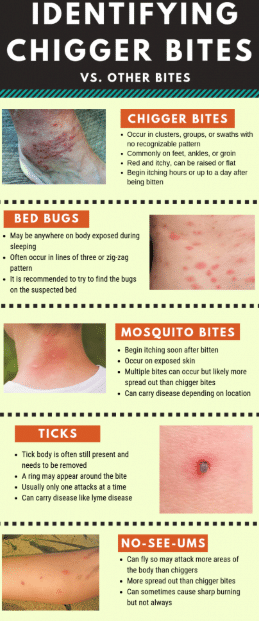Chigger Bites: You might be out for a stroll in the park with your kids. Or maybe enjoying an afternoon on the golf course. That outdoor fun, though, sometimes comes with a price — an itchy rash from pests you can’t even see.

Chigger Bites Images
Chigger mites infest personal skin via areas of contact with vegetation, such as pant cuffs or shirt sleeves and collars. They migrate on the coating in search of an optimal feeding area. A commonplace myth about chiggers is that they burrow into and remain inside the skin. This is not true. Chiggers insert their satisfying structures into the skin and interject enzymes that cause the destruction of host tissue. Consolidating of the surrounding skin results in the development of a feeding tube called a stylostome. Chigger larvae then feed upon the dismantled tissue. If they are not disturbed (which is rarely the case because they cause extraordinary itching) they may feed through the stylostome for a few days.
- Chiggers are the larval (juvenile) form of a type of mite (Trombiculidae).
- Chiggers do not burrow into and remain inside the skin, contrary to popular belief.
- Chiggers inject digestive enzymes into the skin and feed upon the decomposed tissue.
- Pronounced itching is the main symptom of chigger bites.
- Bites may appear as blisters or as flat or raised red areas.
- Treatment involves supportive measures to control itching.
How To Treat Chigger Bites

Sometimes called “berry bugs” or “red bugs,” chiggers populate large sections of the United States — including all of the South, the Great Plains, and the Mid-Atlantic. Though they’re often bright red in color, chiggers are only about the size of a grain of salt — making them almost impossible to spot either in the wild or on a person’s skin.
“Chiggers are a type of immature mite that spend time feeding on small mammals, and also on humans,” says Lee Townsend, Ph.D., an extension professor of entomology at the University of Kentucky in Lexington. Dr. Townsend says that there are many different species of mites, but only a few types that bite during their larval stage. It’s these that are referred to as chiggers. “Not all mites are chiggers, but all chiggers are mites,” he adds.
Unlike mosquitoes, ticks, and other biting bugs, chiggers don’t attach themselves to mammals in order to suck blood. Instead, chiggers feast on skin cells and tissue, Townsend explains. But much like mosquitoes and ticks, chiggers can induce a nasty skin reaction. That reaction, he says, comes from the chigger’s saliva, which they use to break down and digest the cells and tissues they devour.
“Different people react differently to bites, so it can be really difficult to tell the difference between bites of things like mosquitoes from chiggers,” Townsend says. Especially if you’re bitten by a lone chigger, the red welt that forms may look more or less identical to a mosquito bite.
But there are bite characteristics that can show up that can help differentiate chiggers from other bugs. For one thing, chigger bites tend to take itchiness to a whole new level. “I don’t know of many things as intensely itchy as a chigger bite,” says Michael Merchant, Ph.D., a professor of entomology at Texas A&M University in Dallas.
What Do Chigger Bites Look Like
Chiggers are tiny larvae members of the arachnid family and are sometimes called red bugs. Although the larvae are extremely small in size, their bites pack a powerful punch. They’re so tiny that you probably won’t notice when they jump from that tall blade of grass onto your skin. You won’t feel it as they hitch a ride right into your home. When you eventually do feel them, however, they can be extremely itchy.
Chiggers live in tall weeds and grass, in berry patches, and in wooded areas. They may be in your backyard, by the lake, and clustered along your favorite hiking trail. They are most active in spring, summer, and fall afternoons when temperatures are warm and inviting.
They can quickly attach to your skin if you walk by and brush up against vegetation where they live. When the temperature falls below 60˚F (16˚C), chiggers become inactive. They die off when the temperature falls below 42˚F (6˚C).
Chiggers are very tiny and it generally takes a magnifying glass to see them. Adults are about 1/60 of an inch and have eight legs. The larvae are red, wingless, six-legged creatures that measure less than 1/150 of an inch. Because of their red color, you might be able to spot the larvae when they cluster together. After they feast on human skin, they turn a yellowish color.
Scientists call these creatures “trombiculid mites.” But they have a bunch of nicknames. You might hear people call them harvest mites, harvest bugs, harvest lice, mower’s mites, or red bugs. Technically, these critters aren’t insects. They’re “arachnids,” in the same family as spiders and ticks.
Pictures Of Chigger Bites
Chiggers are most common in spring and fall months. While chiggers can be found across the United States, they are more common in the warmer southern and mid-western states.
Common places to find chiggers include:
- long and overgrown grass in fields and gardens
- forests
- grassy areas around lakes and rivers
- berry patches
- beneath rocks
- among weeds
- where large numbers of rodents are present
- areas of high humidity
The easiest method of avoiding chigger bites is simply by avoiding walking in long grass, bushes, or other areas where chiggers may be present. However, this is not an option for everyone.
People who do walk into contaminated areas should use bug sprays that contain DEET. The chemical should be sprayed on both the skin and clothing. People should not apply DEET to infants under 2 months of age or allow children to apply repellent themselves.
According to the Centers for Disease Control and Prevention (CDC), a good bug spray to use on your clothing is permethrin. This kills chiggers as well as mosquitoes and ticks.
Once a person is out of the infested area, they should remove and wash their clothes immediately. A hot shower or bath is then advised, scrubbing the body with soap.
The less time spent among the contaminated vegetation, the fewer chance chiggers have of getting onto a person’s skin.
What do chigger bites look like?
Usually, several chiggers are able to latch onto a person walking through an infected area. … You may notice a bright red dot in the center — this is a remnant of the tube your skin formed in response to the chigger’s saliva. The bumps may look like welts, blisters, pimples, or hives.
How do I treat chigger bites?
Then treat your bites with an over-the-counter anti-itch cream or ointment, like menthol, calamine lotion, or hydrocortisone. You can also get relief if you take antihistamine pills or use a cold compress. Chigger bites usually get better on their own.
How long do chiggers live on the human body?


